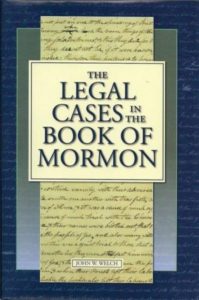 Title: The Legal Cases in the Book of Mormon
Title: The Legal Cases in the Book of Mormon
Author: John W. Welch
Brigham Young University Press, 2008. 524 pages.
Reviewed by Peter Wilson, August 2020
John Welch’s Legal Cases in the Book of Mormon shows how the Law of Moses informs the Book of Mormon, particularly in episodes that are explicitly legal (like the trial of Korihor or trial of Abinadi) or have legal connotations (like the story of Sherem).
It is remarkable how legal cases in the Book of Mormon are consistent with the Law of Moses. For example, in the trial of Korihor in Alma 30, the text mentions that the judge sees that Korihor “would revile even against God” (Alma 30:29) and later, that Korihor “went on to blaspheme” (Alma 30:30). These details might seem odd or arbitrary to modern readers, but they are both defined crimes according to the Law of Moses: Exodus 22:28 forbids reviling against the gods, and Leviticus 24:16 states that blasphemy is punishable by death.
After Korihor’s back-and-forth with Alma, Korihor asks Alma for a sign to prove that God is real. Of this, Welch writes, “Properly or officially consulting the gods through omens, divination, oaths, and ordeals was indeed a fairly normal practice in ancient Israelite and ancient Near Eastern trials” (121). This idea that the divine manifest their will in the judicial process is present in ordeal of bitter water in the Torah, and in other Near Eastern laws, such as in the related river ordeal outlined in the Law of Hammurabi. With this as background, we should not be surprised that Sherem and Korihor challenged Jacob and Alma, respectively, to produce a miracle within a legal context: Welch writes, “seeking oracular signs would have been a likely . . . legal strategy” (124). Welch also writes that people actually believed that dramatic divine manifestations did occur in ancient trials, and cites (among other references) an Aristophanes play where the litigant miraculously becomes mute, as in the outcome of the trial of Korihor.
While the Book of Mormon authors explicitly say that they followed the Law of Moses, and there are many instances of impressive consistency between the Law of Moses and the legal world of the Book of Mormon, it is also clear that the Book of Mormon contains several legal ideas foreign to the law of Moses. The reforms instituted by King Mosiah which establish “a reign of the judges” also include some freedom of belief: “Now the law could have no power on any man for his belief” (Alma 1:17). This law, of course, doesn’t seem to be in total agreement with the previously mentioned death sentence for blasphemy in the Law of Moses.
Welch suggests that one reason why Korihor is brought before several different legal and religious decision makers before his final confrontation with Alma and the Nephite chief judge is because the correct judgment is actually not clear due to this tension between the Law of Moses and King Mosiah’s legal reforms. Welch suggests that the judgment of Korihor would need to wrestle with the answer to the following question:
Should speech be considered merely to be an assertion of one’s beliefs and therefore protected under the civil law and punishable only by divine justice, or should some speech acts be viewed as a type of overt action punishable by civil or religious authorities? (278).
I found this tension between the Law of Moses and Mosiah’s legal reforms interesting and I wish Welch had included some more discussion of differences between ancient Jewish law and the legal culture in the Book of Mormon. For example, the Book of Mormon emphasizes liberty and freedom in the so-called “war chapters” in Alma, and these ideas are not emphasized in the Law of Moses, as far as I can tell.
Another interesting aspect of the book is the comparison of Sherem, Nehor, and Korihor. Often, I think readers of the Book of Mormon (myself included) have a tendency to lump these characters into one. However, it was eye-opening to realize that Sherem was a sort of religious fundamentalist, who believed that the Nephite society was not following the Law of Moses properly while Korihor was a radical atheist. Welch speculates anti-Messiah, pro-Law of Moses arguments that Sherem might have made and concludes that Sherem “may have contested Jacob’s doctrines and interpretations of the law for thoroughly pious reasons,” an idea that I think few readers of the Book of Mormon have ever considered (110).
As something of an amateur historian (although even that modest title overestimates my interest and study), I appreciated this book because it opened my eyes to how the legal world could provide insight into the strangeness of the past. I have heard it said that the past is a foreign country. I have never read a book that has ever made me face the foreignness of the religious past as head-on as this book has. The reason why is that this book is full of scholarship about how ancient legal systems (particularly Jewish legal systems) worked, and the legal systems lay the culture bare.
For example, I like many others, have been appalled upon flipping through the first books of the Bible and realizing how frequently the death penalty is the explicit punishment for different crimes in the Law of Moses. I am still grateful that our modern legal system has moved away from that, but it was still eye-opening to realize the flip side of widespread capital punishment: imprisonment was largely unthinkable in ancient societies. John Welch writes, “A pit, cistern, or dungeon might be used occasionally for temporary restraint, but long-term imprisonment was rarely an option” (7). This forms a sharp contrast with the USA, which has an incarcerated population of 2,300,000 people.
I had not read much about the Law of Moses and this book engendered a desire to learn more about it.
